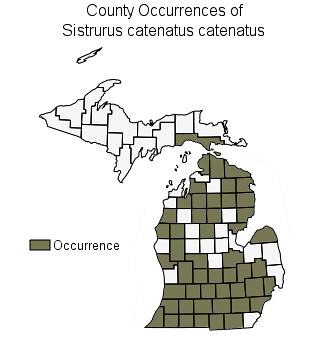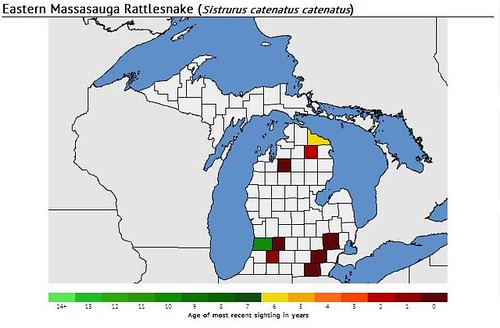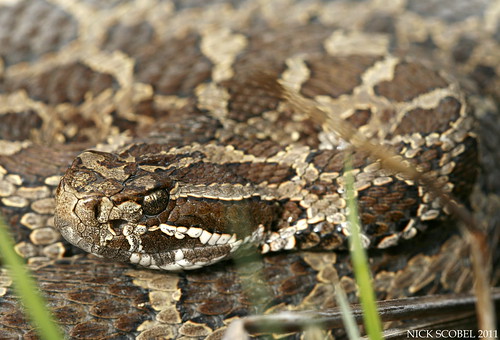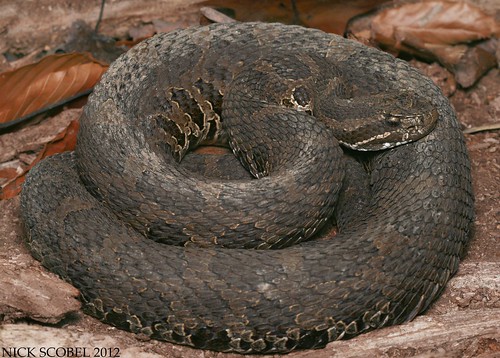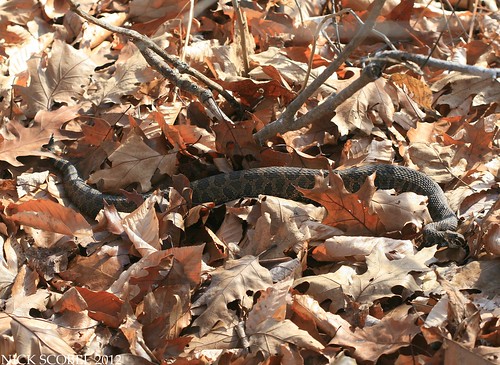Historic Distribution in Michigan © Michigan Natural Features Inventory
Michigan Herp Atlas Records (2002-2012)
As you can see, there is quite a discrepancy between the historical statewide distribution of the massasauga, and its occurrences in the last ten years through the Michigan Herp Atlas project. Does this mean that massasaugas are no longer found in most of their historic range? Not at all, but there are certainly counties on the historic map which have not had massasauga observations for twenty years or more. The concentrations recognized in the herp atlas map are accurate in terms of the three major clusters in the state; southeast, southwest, and northern. According to Yu Man Lee, we have presence data on massasaugas for a little more than two dozen populations statewide. Of those, the state and MNFI only have viable population data for 4 populations. All four are heavily researched sites, two in southeast Michigan and two in southwest Michigan. This staggeringly low number begs the question; why don't we have more data on massasauga populations? The answer is simple, time and money. State agencies like the DNR and MNFI do not have the time, staffing, or resources to survey statewide for this species year in and year out. Thus, we have a very poor understanding the current viability and distribution of this species statewide. With Michigan and parts of Ontario being considered the last strongholds for this species, it is critical that we gain a better understanding of the status of the massasauga in Michigan at a population by population level.
One of the greatest things about the Michigan Herp Atlas project is that it allows regular citizens to contribute observational data in a condensed format, which will help the state gain a better idea of the distribution of its herpetofauna. If you're fortunate enough to encounter a massasauga in the field, please add the observation to the herp atlas project. Not just the location, but its behavior, age class, and habitat type are all important things to note. Juveniles or gravid females are indicative of reproducing populations and can help the state gain a better knowledge of the population health of our only venomous snake, much less that the populations are still extant. After the meeting on Saturday, Chris Boguslawksi and I decided to head to a new location in hopes of finding some massasaugas out in some unseasonably warm November weather and to check the status of this population. We arrived around noon to sunny skies and temperatures in the mid 60s despite a stiff wind. Within a few minutes, I noticed a stocky snake basking out in the open on a rotting long on a forested slope, check the video.
Eastern Massasauga Rattlesnake - Sistrurus catenatus catenatus
Eastern Massasauga Rattlesnake - Sistrurus catenatus catenatus
The habitat at this location is quite unique compared to other massasauga populations I've been to. Most of the suitable habitat is a large stretch of floodplain forest with some adjacent small wetlands. This snake was way out of the lowlands and up in a dry forested area, likely utilizing old rodent burrows as hibernation sites. The snake showed clear signs of being underground for the past few weeks, I took a view in situ shots and let it be. A short time later, I spotted this much nicer looking adult on the crawl in the leaf litter.
We had found two exceptional adults in less than a half hour in November, it was a very good day. The information presented at the MNFI meeting was certainly intriguing and I think there is an opportunity for herpers and Michigan outdoorsmen alike to help close the data gap on this species in Michigan. I'm going to make a point to explore historic populations early in the spring next year to try and confirm if there are still massasaugas located at these unknown populations and two check other areas with suitable habitat. With the status of this awesome species on the brink of extirpation in the states surrounding Michigan, it is wise to gain a better understanding of this snake in our state to ensure it remains the stronghold for this shy rattlesnake.

